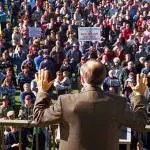
Shortly after noon on April 28th 1996, a lone figure entered the Broad Arrow Cafe in Tasmania’s historic Port Arthur. Once inside, he opened a bag, took out a semi-automatic rifle and fired indiscriminately in the crowded cafe. In the space of just 15 seconds, 12 people received fatal wounds and another nine were seriously injured. The gunman, 28-year-old Martin Bryant, left the cafe and continued his killing spree elsewhere, moving to a gift shop, a car park and then a toll booth. Among Bryant’s victims were young mother Nanette Mikac, shot through the temple as she pleaded for mercy. He then executed Mikac’s daughters Alannah, 6, and Madeline, 3, as horrified onlookers watched from the safety of the bush.
Bryant moved toward the exit, killing indiscriminately as he went. He started his car and drove toward the village of Seascape, firing at passing cars along the way, before arriving at a local boarding house. Police arrived and surrounded the house. During an 18-hour stand-off, Bryant threatened to murder hostages; he also demanded a helicopter to fly him to Adelaide. Bryant was captured the next day, after he had set the boarding house alight. His actions caused the deaths of 35 people. The Port Arthur massacre was Australia’s largest mass murder committed by a single perpetrator and one of the deadliest killing sprees by a lone gunman in history. Martin Bryant is currently incarcerated in Hobart’s Risdon Prison, serving 35 life terms plus a 1,035 year cumulative sentence. There is no prospect that he will be released or paroled.

The Port Arthur killings had a profound effect on Australia. At the time, Australians were not unfamiliar with gun-related mass murders. In 1984 a turf war between biker gangs erupted in the Sydney suburb of Milperra, leading to the shooting deaths of seven people. A total of 16 people died in two 1987 shootings in Melbourne. Only six weeks before the Port Arthur killings, a lone gunman murdered 16 children and a teacher at a school in Dunblane, Scotland (a crime that may have influenced Bryant’s rampage). However, the magnitude of the Port Arthur massacre prompted an unprecedented wave of grief, shock and anger around the nation. Media commentators questioned whether Australia’s liberal gun laws had contributed to the tragedy. Despite a troubled childhood, low intelligence and obvious instability, Bryant had been able to arm himself with Vietnam War-era AR-15 and L1A1 semi-automatic rifles. Both weapons were capable of firing several hundred rounds per minute.

Recognising the strength of public opinion, prime minister John Howard began pushing for law reform and greater gun control. This was a difficult challenge, for several reasons. Howard’s government was not really in a position to implement significant change, having been elected only six weeks earlier. Under the Constitution, the Federal government does not have the authority to pass laws pertaining to weapons, so gun law reform required both considerable state co-operation and bipartisanship. Despite the overwhelming impact of the Port Arthur killings, some States – particularly Queensland, Western Australia and Tasmania – remained hesitant about a crackdown on gun laws. There was pointed opposition in rural areas. Howard toured the country to convince audiences of the need for reform of gun laws. Some of these audiences were openly hostile. On one occasion Howard was shown to be wearing a bulletproof vest.
Despite the great difficulties involved, the Federal government managed to lead nationwide gun reform. A council of police ministers in May 1996 drafted a National Firearms Agreement that was eventually accepted by the States. Amongst its provisions were bans on semi-automatic firearms, a tighter regulation and licensing regime, and a nationwide ‘gun buy-back’ program that saw about 660,000 privately-owned guns surrendered and destroyed. Sociologists suggest that there are about 250 fewer gun murders per annum in Australia, due to the government’s determined stance on gun law reform.
© lawgovpol.com 2014. Content on this page may not be republished or distributed without permission. For more information please refer to our Terms of Use.
